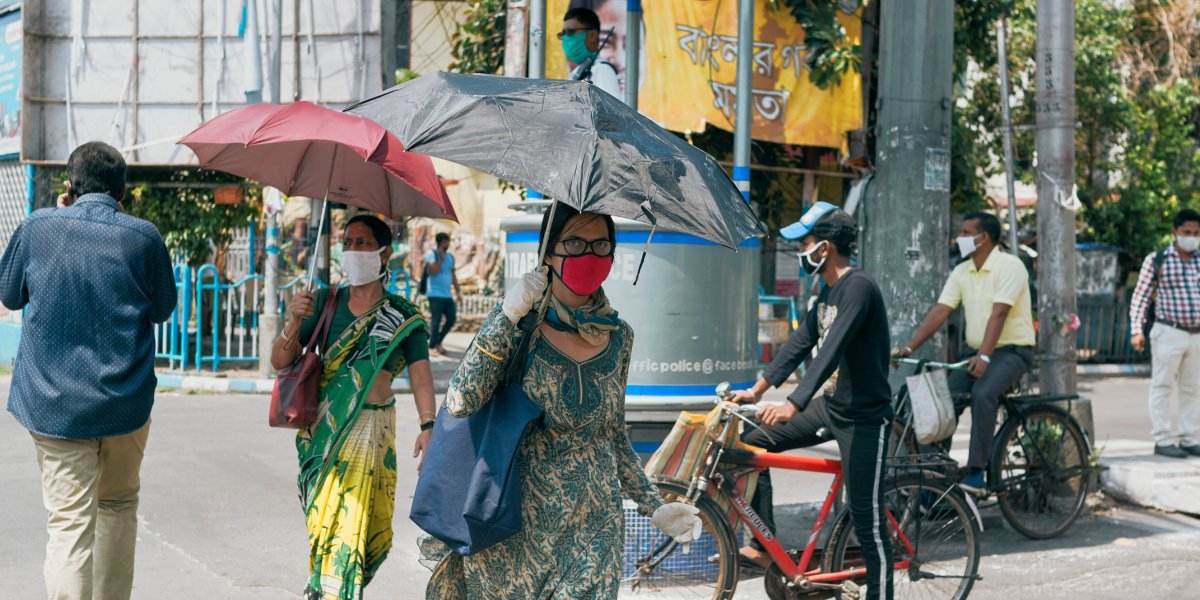Combined impact of heat and air pollution exposure on human health in India: Evidence and solutions (COPE)
The COPE project will develop advanced Early Warning and Decision-support Systems for heat and air pollution in the two major Indian urban conglomerates - Delhi and Kolkata.
Photo: Suprabhat Dutta, iStock
Project details
About the project
India faces increasingly frequent and intense heatwaves, disproportionately affecting vulnerable populations, such as the elderly, children, outdoor workers and those with existing health conditions such as heart and lung diseases. With climate change the likelihood of heatwave events in India is now 30 times higher than it used to be.
At the same time, the air quality in northern India has consistently and severely deteriorated over the last three decades degrading public health. The capital Delhi as well as Kolkata is frequently ranked among the most polluted cities in the world. Exposure to elevated levels of air pollution negatively affects people’s health, again with vulnerable groups facing the highest risk.
Resent research has found that there are synergistic effects of extreme heat and air pollution on health outcomes. This means that the health effects are stronger when there is extreme heat and high air pollution at the same time. However, current heat and air pollution warnings in India do not consider these interactive effects. COPE aims to do something about that.
Addressing the shortcomings of the current individual warning systems for heat and air pollution, COPE will assess the associated health consequences in two major urban conglomerates in India (Delhi and Kolkata) and develop a combined Early Warning and Decision-support System for exposure to both heat and air pollution.
COPE will do this by expanding the scope of an existing early warning system for air quality in Delhi by including exposure to heat, their concurrent exposure and health impact forecasts and evaluating its advantages, along with investigating the social and behavioral factors that impede their efficacy.Further, the project will develop a similar Early Warning and Decision-support System for heat and air pollution for Kolkata. COPE will also pinpoint other cities in India that could benefit from implementation of a similar early warning system. In this way the project aims to help local authorities and vulnerable groups to prepare better and thus contribute to mitigate the health impacts of exposure to heat and air pollution in India.
The research will be co-designed and conducted in collaboration with user groups from vulnerable groups and stakeholder partners from the health and governmental sector. The operationalization of the EWDS will be carried out by IITM, leveraging their position within the Ministry of Earth Sciences (MoES) and extensive expertise in developing and implementing the AQEWS.
COPE brings together a multidisciplinary consortium with partners from India, Norway, the UK, the US and Australia. The team includes climate scientists from CICERO Center for International Climate Research (Norway), Indian Institute of Technology Delhi (IITD, India), Indian Institute of Tropical Meteorology (IITM, India) and University Corporation for Atmospheric Research (UCAR, USA), epidemiologists at The London School of Hygiene and Tropical Medicine (LSHTM, UK), University of Queensland (UQ, Australia) and IITD, social scientists at NCAR and Environment Conservation Society -SwitchOn non-governmental organization (SwitchON, India), and a communication team from CICERO and SwitchON. The consortium will leverage the groundwork laid by the project coordinators, which quantifies health risks associated with combined heat and air pollution exposure in Europe, as well as Delhi air quality early warning system (AQEWS) co-developed by the partners at IITM and NCAR.
COPE Advisory Board
-
Prof. Subimal Ghosh (Interdisciplinary Programme in Climate Change, Indian Institute of Technology Bombay),
-
Dr. Sarath Guttikunda (urbanemissions.info)
-
Dr. Shubhayu Saha (Office of Climate Change and Health Equity, Centers for Disease Control and Prevention),
-
Prof. Alexandra Schneider (Institute of Epidemiology, Helmholtz Munich),
-
Prof Kristi Ebi (Center for Health and the Global Environment, University of Washington),
-
Prof Pradip Swarnakar (Department of Humanities and Social Sciences, Indian Institute of Technology Kanpur)
COPE partner Institutions
-
CICERO Center for International Climate Research (Norway)
-
Kristin Aunan
-
Sourangsu Chowdhury
-
Miriam Stackpole Dahl
-
Marit Sandstad
-
Suzanne Day
-
-
Indian Institute of Technology Delhi (IITD, India)
-
Sagnik Day
-
-
Indian Institute of Tropical Meteorology (IITM, India)
-
Sachin Ghude
-
Gaurav Govardhan
-
Rajmal Jat
-
-
University Corporation for Atmospheric Research (UCAR, USA)
-
Olga Wilhelmi
-
Rajesh Kumar
-
Forest Lacey
-
-
The London School of Hygiene and Tropical Medicine (LSHTM, UK)
-
Antonio Gasparrini
-
Malcolm Mistry
-
-
Environment Conservation Society -SwitchOn (India)
-
Aditi Kundu
-
Vinay Jaju
-
-
University of Queensland (UQ, Australia)
-
Nicholas Osborne
-
Involved CICERO staff
From other institutions
Sagnik Dey, Malcolm Mistry, Antonio Gasparrini, Olga Wilhelmi, Rajesh Kumar, Aditi Kundu, Vinay Jaju, Gaurav Govardhan, Sachin Ghude, Forrest Lacey, Nicholas Osborne

